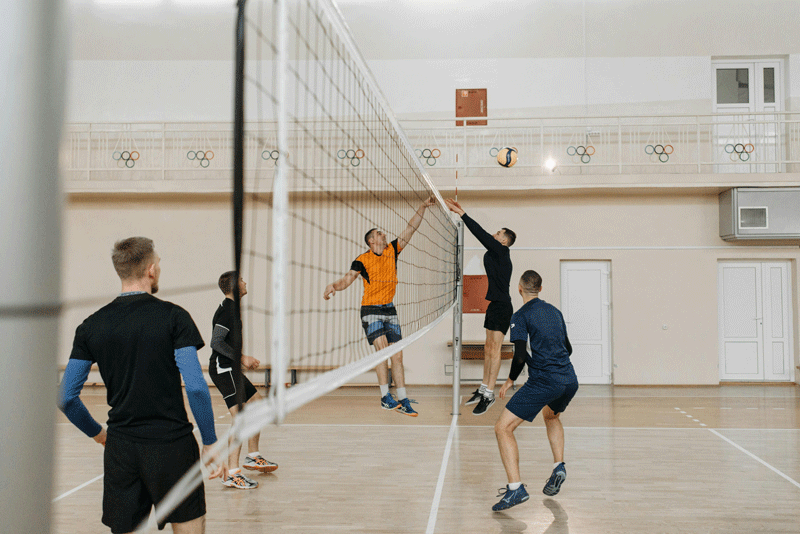How Many Sets In Middle School Volleyball?: Also Points & Rules
Middle school volleyball games follow distinct rules compared to higher levels of play, leading to significant differences in game format and duration. Many people wonder about the duration of middle school volleyball games.
In middle school volleyball matches, teams compete in a best-of-three-sets format. The victor is determined by winning two out of the three sets. The first two sets are played to 25 points, while the third set is played to 15 points.
This set structure results in middle school volleyball games being notably shorter than their high school counterparts, and this difference is purposeful. However, the variation in game duration is not the only rule difference distinguishing middle school volleyball from higher levels.
How Many Sets In Middle School Volleyball? For a comprehensive understanding of middle school volleyball set rules, factors influencing game duration, additional rule variations, and some tips for spectators, continue reading below.
Official Game Duration Regulations

Middle school volleyball games are governed by state-level athletic bodies, all adhering to the same duration rules. Typically, these games consist of three sets, with the winner being the team that claims victory in two sets.
A common inquiry revolves around how many points a team must accumulate to win a set in middle school volleyball. To secure a set win, a team must amass 25 points with a 2-point lead. Thus, a scoreline of 25-23 or better clinches the set.
In closely contested matches, play continues until one team establishes a 2-point lead, such as 28-26.
However, there’s a discrepancy in point-cap rules across different match categories. Most middle school leagues do not impose a point cap, allowing sets to extend beyond the standard 25 points if necessary.
Friendly games, on the other hand, may enforce a point cap to prevent excessive fatigue among players. Competitive matches typically forego point caps to foster a competitive environment.
To win the overall game, a team must emerge victorious in two sets. If a team wins both the first and second sets, they win the game outright. However, if the match is tied at 1-1 after two sets, a decisive third set is played.
The third set, also known as the match-deciding set, is played up to 15 points, with a 2-point gap required for victory. Thus, a team can clinch the game with a scoreline of 15-13 or 16-14 in the third set. Winning the third set secures the game victory.
Given the limited number of sets (up to three), middle school volleyball games typically last less than an hour. Rallies tend to be brief in middle school due to the players’ developing skills, with most points decided within 10 to 15 seconds.
Factors Influencing Game Duration
When middle school volleyball teams are evenly matched, matches can become intense and drawn out. Although it’s not a common occurrence due to the developing mental composure of young athletes, sets can extend beyond the norm, sometimes lasting over an hour.
I’ve personally experienced and witnessed 13-year-olds fiercely battling for points, resulting in scorelines like 36-36 or even higher.
Volleyball is a sport characterized by its unpredictability, where a seemingly dominant team can suddenly lose momentum, leading to unexpected outcomes. I’ve been on the receiving end of such turnarounds numerous times.
Conversely, when there’s a significant disparity in team quality, matches tend to be shorter, with the superior team swiftly concluding the game.
Timeouts play a crucial role in-game strategy and management. Each team is granted one timeout per set. When a timeout is called, both teams retreat to the bench to confer with their coach and grab refreshments. However, the team that didn’t call the timeout retains theirs.
Timeout durations typically range from 30 to 90 seconds, depending on the discretion of the referee. Some referees adhere strictly to time limits, while others may be more lenient, recognizing that middle schoolers are children who may benefit from a longer break. Nevertheless, referees generally avoid allowing excessively long timeouts to preserve the match’s rhythm.
The most common reasons for a volleyball game to extend beyond its expected duration include:
- injuries
- technical issues
- crowd trouble

Injuries represent a significant concern for parents, although volleyball is generally considered a safe sport. Nonetheless, players can sustain injuries such as sprained ankles or fingers from awkward landings or facial injuries from ball impacts, though these occurrences are relatively rare and usually not severe.
In the event of an injury, coaches and referees typically pause the game to assess the player’s condition, potentially leading to a brief delay. In extreme cases, if a serious injury occurs, the game may be canceled altogether.
Technical issues with the court, net, or scoreboard can also cause delays as they are addressed and resolved.
Furthermore, crowd-related issues, such as difficulties in locating the school gymnasium, particularly for visitors unfamiliar with the area, can lead to delays ranging from a few minutes to half an hour.
It’s crucial to recognize that middle-school players have limited stamina and focus compared to adults, which is why games are intentionally limited to three sets. Extending the game to five sets would risk diminishing excitement, making it less engaging for spectators, and potentially leading to decreased player performance.
Common Scenarios and Variations
The shortest possible middle school volleyball game concludes after just two sets, a scenario typically seen when one team significantly outmatches the other. Such games rarely extend beyond 40 minutes.
When a game progresses to three sets, it may last up to an hour, although instances of games exceeding this duration are rare.
Games lasting over an hour typically occur when both teams are closely matched, resulting in intense rallies where each point is fiercely contested. In these cases, a single rally can consume up to half a minute, and when factoring in timeouts and other minor breaks, the game’s duration can exceed an hour.
Nevertheless, these closely contested matches are a delight to watch, often surprising spectators with the level of skill demonstrated by middle-school players. Sets in such matches are often closely contested, with one team barely securing a two-point lead and point scores surpassing 30.
Long games often look similar to this:
Set 1: Team A 29-27 Team B
Set 2: Team A 30-32 Team B
Set 3: Team A 16-18 Team B
On average, middle school volleyball matches typically span from 30 minutes to an hour in duration.
Comparison with High School and Professional Volleyball Games

High school volleyball games follow a similar format to professional volleyball, with matches played over a maximum of five sets. To secure victory, a team must win three sets. Consequently, high school matches tend to be longer compared to middle school games.
In both high school and professional volleyball, it’s common for all five sets to be played, leading to match durations of up to two hours. The point systems mirror each other, with sets won by reaching 25 points, and the match-deciding set played to 15 points, all with a 2-point difference requirement.
Rallies in high school and professional games typically last longer due to the higher skill level of the players. As a result, it becomes more challenging to score points efficiently.
While games may experience delays due to technical issues or crowd-related matters, such occurrences are rare. However, games are seldom paused or canceled due to player injuries.
Overall, a five-set high school or professional volleyball match can last anywhere from an hour to, in exceptional cases, over two hours.
Practical Tips for Attendees
Here are some tips for enjoying a middle school volleyball game:
Arrive early to secure good seats, especially if the school has a passionate crowd. Latecomers might find themselves standing for the entire game.
Remember to bring drinks to stay hydrated throughout the game. Check if the host school allows props, as some venues may have restrictions.
Take advantage of the breaks between sets for restroom breaks if needed.
Most importantly, have fun and support your child playing with enthusiasm. After all, you’re their number-one fan!
Real-Life Insights

I witnessed a notable incident during a high school volleyball game that resulted in a significant delay beyond our control. It was not a middle school game, but rather a high school match, where a supporter attending to cheer for their grandson suffered a heart attack during the second set.
The game was promptly halted as first aid was administered, and we awaited the arrival of emergency medical technicians (EMTs). Fortunately, the individual survived, but the entire episode caused a delay of approximately half an hour.
Upon consulting with the referee, we agreed to resume the game. However, we requested to restart the second set, as the incident occurred with the score at 8-10. Additionally, we asked for a 10-minute warm-up period to regain our momentum, as the unexpected delay had caused us to cool down.
Despite our efforts, we ultimately lost the game. The match, which initially began as routine, lasted nearly three hours, not due to the heart attack, but rather due to our team’s performance. This experience served as a poignant reminder of the unpredictability of life and the importance of being prepared for unexpected circumstances.
Conclusion: How Many Sets In Middle School Volleyball?
I hope this article has provided thorough answers to all your questions, offering insight into the duration of volleyball games, factors contributing to extended playtimes, and how external influences can impact the game.
In summary, middle school volleyball matches typically consist of three sets and typically last between half an hour to an hour. While technical issues and injuries may occasionally cause delays, such occurrences are rare.
To enhance your enjoyment of the game, consider arriving early to secure prime seating, and don’t forget to cheer enthusiastically for your team!
Also Read: How Tall Are Setters In Volleyball?
